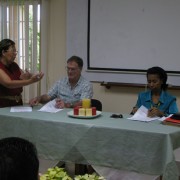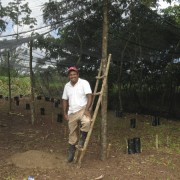Scientific Research, Honduras
Inga Alley Cropping is based on extensive scientific research undertaken over a number of years with the support of the University of Cambridge. The main focus of the Inga Foundation is now the outreach and extension of Inga alley cropping to slash-and-burn farms. However, holding true to our scientific roots, we believe that scientific research is essential to ensure we can provide the very best advice and support to the farmers we work with. In Honduras, we have an area of mature Inga alleys for research purposes located within the grounds of the Centro Universitario Regional del Litoral Atlantico (CURLA University), in La Ceiba city.
History
The research plots at CURLA were planted in 1996 and comprised 6 Inga species. From that time on, these plots in CURLA served as a demonstration and research center for Inga Alley Cropping. Adjacent to the city, it is ideally placed to allow us to showcase our techniques in practice as it is easily accessible. Due to a lack of funds, the CURLA alley plots were neglected for several years up until 2011, when we were able to secure the funds to restore the plots to viable status with the two most effective species, Inga edulis and I.oerstediana. 18 months after the replanting took place, the site made a spectacular recovery, and was ready for use once again.
New Long Term Research Project
The fact that these plots have now been under Inga Alley Cropping for 17 years, makes them the oldest area of continuous Inga Alley Cropping in the world and, as such, they are an invaluable resource for research into the long term effects of Inga alley cropping.
In partnership with CURLA University, we have now completed the design for a new long term research experiment using these plots. The official partnership agreement with the University for the new project has now been signed and the experiment started in March 2014. The experiment is using 4 crop species; Maize, Chili Tabasco, Pineapple and the Datil Banana, all of which could become key cash crops for use with Inga Alley Cropping. We will be applying multiple levels of 2 key nutrients – phosphorus and potassium – to different sections of the plots in order to determine the minimum level of these nutrients that a farmer would need to add to ensure good yields over the long term.
- Signing the official partnership agreement with the University for the new research project
- Research Project Notice Board
- The first prune, marking the beginning of our new long-term research project
- Constructing the nrusery for the dactil banana
- The finished Dactil Banana Nursery
Previous research tells us that a key aspect of the Inga Alley Cropping system is that it is highly efficient in retaining nutrient inputs, recycling them within the system. By contrast, in traditional agriculture, soil supplements are often rapidly lost from the soil, especially on the very steep slopes which most farmers in Honduras are forced to cultivate. Hence, we know that the input of soil supplements required for good harvests is likely to be significantly lower in the Inga alley system than what’s normally required. However, to be able to give the best and most accurate advice we can to the farmers we work with, we need to know exactly how much lower. This experiment aims to generate reliable, accurate data in relation to key cash crops regarding the minimum level of inputs needed to sustain good harvests year on year. With this information we are able to fine-tune our advice to local farmers, allowing them to get the very best value from the Inga alley system.
The Biological Corridor
Planted in 1999, the mini-biological corridor in CURLA serves as an example of how Inga can be used in conservation to reconnect areas of forest.
The agressive grasses which typically dominate slashed and burned sites can often make reforestation difficult and costly as the rainforest seedlings are easily outcompeted and smothered by the grasses. However, Inga can help to control the grasses and weeds, allowing the rainforest trees to survive and grow.
In this system, Inga are planted at 5 yard spacings to begin the process of site recapture from the aggressive grasses (in this case mainly Rottboellia cochinchinensis and Digitaria swazilandensis). Each 4th Inga was replaced by one of 15 native rainforest tree seedlings for which the Inga would act as a “nurse” tree.
After 16 years the biological corridor is now performing exactly as intended. Some of the trees have reached 70 feet or more in height and have begun to form buttresses. The corridor is full of all kinds of birds, from owls to woodpeckers and hummingbirds, as well as insects and other animals and the soil’s physical appearance is beginning to resemble that of a rainforest. The corridor is now a very valuable educational resource for teaching Forestry students about Inga’s potential for restoring links between isolated forest blocks.
The elegant ivory stem of a 65-foot individual of Terminalia oblonga (Combretaceae)
The consequence of the successful establishment of a forest canopy is that the Inga are now beginning to be shaded out as the natural process of succession moves forward and the forest becomes established.
Left: Spondias mombin (Anacardiaceae). Probably redistributed by nocturnal mammals.
Right: Xylopia frutescens (Annonaceae) almost certainly brought in by Toucans which are commonly seen in the trees.
Saplings of rain forest tree species that have germinated following their transport here by birds or animals using the corridor for its protective feeding environment









